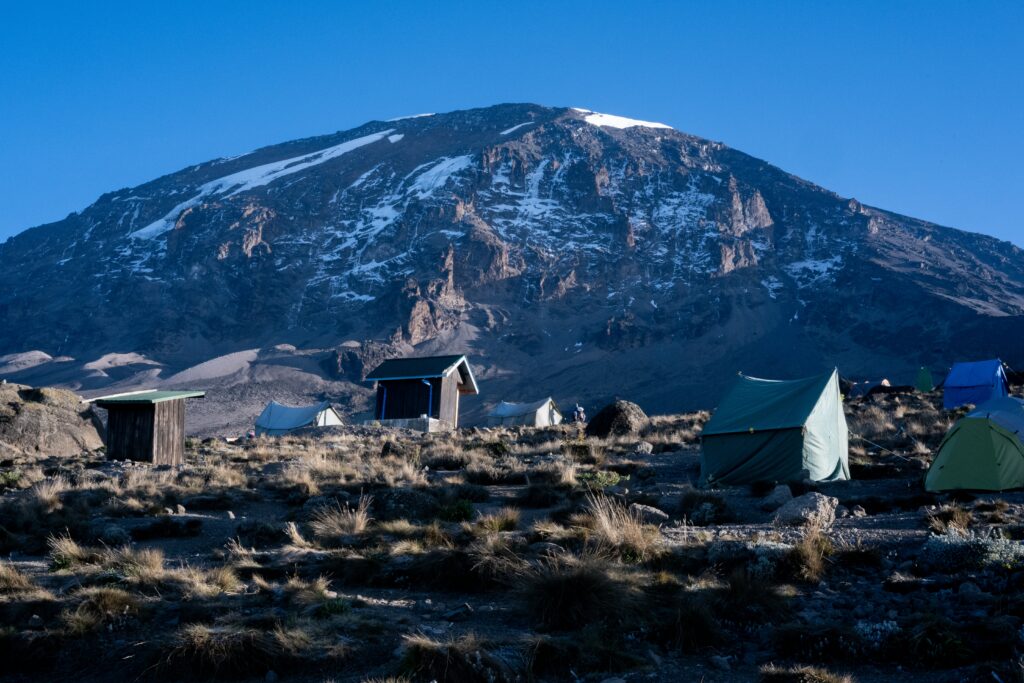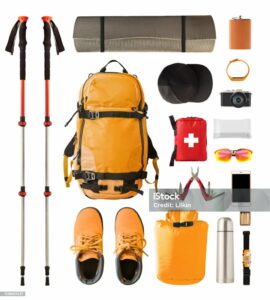Conquer the Sky: Exploring the Majestic Height of Mount Kilimanjaro

Welcome to the breathtaking world of Mount Kilimanjaro, where adventure and natural beauty collide. Standing tall at a staggering 19,341 feet, this majestic mountain is truly a conqueror’s dream. As you ascend through lush rainforests, picturesque moorlands, and icy glaciers, you will witness the awe-inspiring landscapes that have captivated explorers and travelers for centuries.
In this article, we delve deep into the heart of Kilimanjaro, exploring its unrivaled beauty, challenging terrain, and captivating history. Whether you’re an experienced hiker or a first-time adventurer, at Roam Wild Adventure we’ll equip you with valuable tips and insights to make your journey to the summit a memorable one.
Lace-up your boots and prepare to be amazed by Kilimanjaro’s diverse ecosystems, from the dense vegetation of its lower slopes to the barren lunar-like landscapes near the peak. Discover the vibrant flora and fauna that call this mountain home and learn about the rich cultural heritage of the local communities that surround it. Come explore with us!
Join us as we embark on an exhilarating expedition to the rooftop of Africa. Are you ready to conquer the sky and experience the awe-inspiring beauty of Mount Kilimanjaro? Let’s begin this incredible journey together.
The allure and challenge of climbing Mount Kilimanjaro
Mount Kilimanjaro has long been a magnet for adventurers seeking to conquer its majestic peak. The allure of standing at the highest point on the African continent, surrounded by breathtaking vistas, is irresistible to many. However, make no mistake, Kilimanjaro is not a mountain to be taken lightly. Its high altitude, extreme weather conditions, and challenging terrain require careful preparation and a determined spirit.
Despite the challenges, the rewards of climbing Kilimanjaro are immeasurable. As you ascend through its diverse ecosystems, you’ll witness nature’s beauty in all its glory. From the lush rainforests teeming with life to the otherworldly landscapes that resemble the surface of the moon, every step is a revelation. The sense of accomplishment and the memories created along the way make the journey to the summit an experience of a lifetime.
Mount Kilimanjaro facts and statistics
Before embarking on any adventure, it’s essential to familiarize yourself with the facts and statistics of the mountain you’re about to conquer. Mount Kilimanjaro, located in Tanzania, is the highest freestanding mountain in the world. It consists of three volcanic cones: Kibo, Mawenzi, and Shira.
Topping at a height of 19,341 feet (5,895 meters), Kilimanjaro attracts climbers from all over the world. The mountain is known for its unpredictable weather, which can range from scorching heat to freezing cold. It’s important to note that Kilimanjaro’s peak is covered in ice and snow, making it a challenging and potentially hazardous climb.
Choosing the right route for your Kilimanjaro climb
When it comes to climbing Kilimanjaro, choosing the right route is crucial to your success and enjoyment. There are several routes to the summit, each offering a unique experience and varying levels of difficulty. The most popular routes include the Machame, Marangu, Lemosho, Northern Circuit, and Rongai routes.
The Machame route, also known as the “Whiskey” route, is a favorite among experienced climbers. It offers stunning views and a high success rate, but requires a good level of physical fitness. The Marangu route, on the other hand, is often referred to as the “Coca-Cola” route due to its popularity. It provides hikers with comfortable sleeping huts along the way, making it a popular choice for those who prefer more creature comforts.
The Lemosho, Northern Circuit, and Rongai routes are less crowded and offer a more secluded experience. These routes are known for their breathtaking scenery and provide climbers with a chance to immerse themselves in the beauty of Kilimanjaro without the hustle and bustle of larger groups.

Preparing for your Mount Kilimanjaro expedition
Preparing for a Mount Kilimanjaro expedition requires careful planning and preparation. Before setting foot on the mountain, it’s important to consult with a qualified guide or tour operator who can provide you with the necessary information and guidance.
One of the most crucial aspects of preparation is physical fitness. Climbing Kilimanjaro requires a good level of cardiovascular fitness, as well as strength and endurance. Engaging in regular exercise, such as hiking and running, can help prepare your body for the physical demands of the climb.
In addition to physical fitness, proper acclimatization is key to a successful summit. Climbers should allow sufficient time to adjust to the altitude and should consider including rest days in their itinerary. With Roam Wild Adventure, extra acclimatization time is a standard part of our Lemosho, Machame, Rongai, and Northern Circuit routes. Hydration is also crucial, as the high altitude can lead to dehydration. Drinking plenty of water and avoiding caffeine and alcohol can help prevent altitude sickness.

Essential gear and equipment for climbing Mount Kilimanjaro
When it comes to climbing Kilimanjaro, having the right gear and equipment is essential for your safety and comfort. Here are some of the essential items you’ll need for a successful climb:
1. Hiking boots: Invest in a good pair of waterproof, comfortable hiking boots that provide ankle support.
2. Layered clothing: Pack a variety of clothing layers to adapt to changing weather conditions. Include thermal base layers, fleece jackets, and a waterproof outer shell.
3. Sleeping bag: Choose a sleeping bag suitable for cold temperatures. Look for one with a comfort rating of -10°C to -15°C.
4. Trekking poles: Trekking poles provide stability and support during the climb, especially on uneven terrain.
5. Headlamp: A headlamp is essential for early morning starts and navigating in the dark.
This is not a comprehensive list by far, but just an outline of some of the basic items needed. Contact us for more information on a full packing list or visit our article on “What to Bring…”
Training and physical preparation for climbing Mount Kilimanjaro
Preparing your body for the physical demands of climbing Kilimanjaro is crucial for a successful summit. Training should include a combination of cardiovascular exercises, strength training, and hiking to build endurance and stamina.
Cardiovascular exercises such as running, cycling, or swimming can help improve your overall fitness and endurance. Incorporating strength training exercises such as squats, lunges, and core exercises will help build strength in your legs and core, which are essential for the climb.
In addition to regular exercise, it’s important to spend time hiking and getting used to walking with a backpack. Gradually increase the duration and intensity of your hikes to simulate the conditions you’ll encounter on Mount Kilimanjaro.
The stages of climbing Mount Kilimanjaro
Climbing Mount Kilimanjaro is not a sprint but a carefully paced journey. The climb is usually completed over a period of 6-8 days, allowing climbers to acclimatize to the altitude and reduce the risk of altitude sickness. Here are the stages typically encountered during a Kilimanjaro climb:
1. Machame Gate to Machame Camp: The first day involves a gentle hike through the rainforest, where you’ll encounter a variety of flora and fauna.
2. Machame Camp to Shira Camp: On day two, the trail becomes steeper as you ascend through heath and moorland zones, offering stunning views of the surrounding landscapes.
3. Shira Camp to Barranco Camp: Day three involves a gradual climb to the Lava Tower, followed by a descent to Barranco Camp. This day is often referred to as an acclimatization day.
4. Barranco Camp to Karanga Camp: The fourth day includes a challenging climb up the Barranco Wall, followed by a descent to Karanga Camp.
5. Karanga Camp to Barafu Camp: Day five involves a steep climb to Barafu Camp, located at the base of Kilimanjaro’s summit.
6. Barafu Camp to Uhuru Peak: On the final day, you’ll embark on a midnight summit push to reach Uhuru Peak, the highest point on Kilimanjaro. The descent is made to Mweka Camp.
Safety precautions and tips for a successful climb
Climbing Mount Kilimanjaro is a challenging endeavor, but with proper preparation and precautions, it can be a safe and rewarding experience. Here are some safety tips to keep in mind:
1. Acclimatize properly: Allow for sufficient acclimatization to reduce the risk of altitude sickness. Follow the “climb high, sleep low” principle and consider including rest days in your itinerary.
2. Stay hydrated: Drink plenty of water to stay hydrated, as the high altitude can lead to dehydration. Avoid caffeine and alcohol, as they can exacerbate the effects of altitude sickness.
3. Listen to your body: Pay attention to any signs of altitude sickness, such as headaches, nausea, or dizziness. If symptoms persist or worsen, descend to a lower altitude and seek medical attention if necessary.
4. Follow your guide’s instructions: Your guide is experienced and knowledgeable about the mountain. Listen to their instructions and follow their advice for a safe and successful climb.
5. Pack essential medications: Bring any necessary medications, such as altitude sickness medication or pain relievers, and ensure they are easily accessible during the climb.
Conclusion and personal reflections on conquering Mount Kilimanjaro
Reaching the summit of Mount Kilimanjaro is an achievement that will stay with you for a lifetime. The sense of accomplishment, the breathtaking views, and the memories created along the way make the journey to the rooftop of Africa truly unforgettable.
As you conquer the sky and explore the majestic height of Kilimanjaro, remember to embrace the challenges, appreciate the beauty of the landscapes, and respect the mountain and its local communities. Kilimanjaro is not just a mountain; it’s a symbol of strength, perseverance, and the indomitable human spirit.
So lace up your boots, prepare for the adventure of a lifetime, and let Mount Kilimanjaro’s allure and beauty inspire you to conquer new heights. Are you ready to embark on this incredible journey? The majestic peak awaits your arrival.
Contact us to help you plan this bucket list trip!